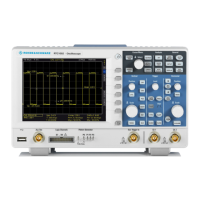For Your Safety
R&S
®
RTC1000
6Getting Started 1335.7346.02 ─ 02
Risk of instrument damage
An unsuitable operating site or test setup can damage the instrument and
connected devices. Ensure the following operating conditions before you
switch on the instrument:
●
Read and observe the "Basic Safety Instructions" brochure and the
safety instructions in the manuals.
●
Observe the operating conditions specified in the data sheet. Note that
the general safety instructions also contain information on operating
conditions.
●
Position the instrument as described in the following sections.
Make sure that all fan openings are unobstructed and the airflow perfo-
rations are unimpeded. The minimum distance from the wall is 10 cm.
●
Signal levels at the input connectors are all within the specified ranges.
●
Signal outputs are correctly connected and are not overloaded.
Instrument damage caused by electrostatic discharge
Electrostatic discharge (ESD) can damage the electronic components of the
instrument and the device under test (DUT). Electrostatic discharge is most
likely to occur when you connect or disconnect a DUT or test fixture to the
instrument's test ports. To prevent electrostatic discharge, use a wrist strap
and cord and connect yourself to the ground, or use a conductive floor mat
and heel strap combination.
Electromagnetic interference (EMI) may affect the measurement results.
To suppress generated electromagnetic interference (EMI):
●
Use suitable shielded cables of high quality. For example, use double-
shielded RF and LAN cables.
●
Always terminate open cable ends.
●
Note the EMC classification in the data sheet.

